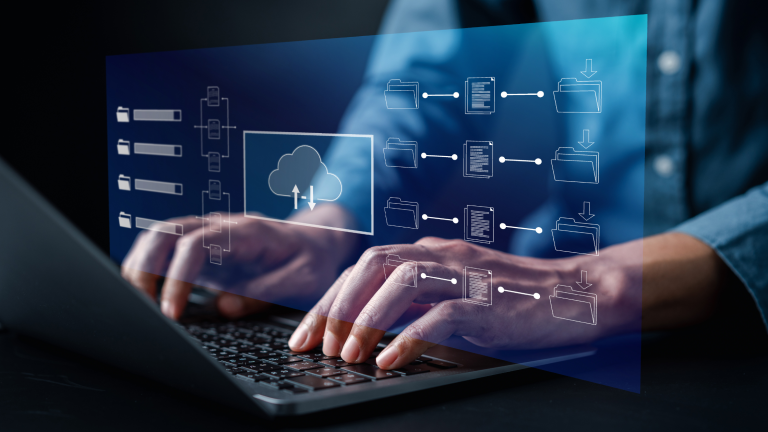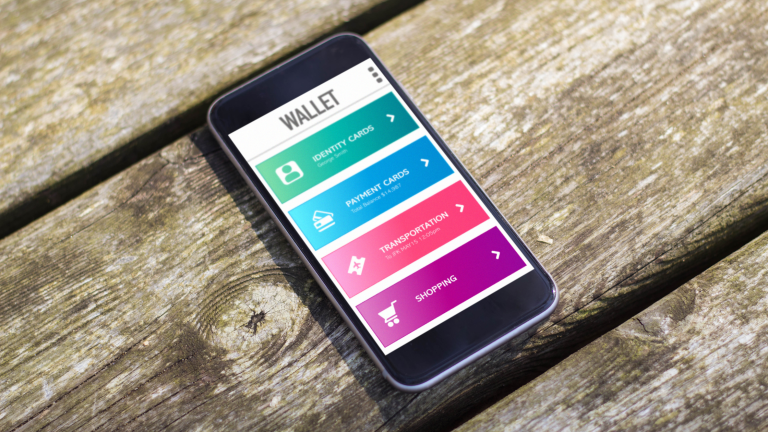For most SaaS enterprises, customer support is the single largest operational expense, often consuming 15–25% of total operating costs. Yet unlike manufacturing businesses where production costs scale predictably with volume, SaaS companies face a harsher reality: as the customer base grows, support complexity grows exponentially not linearly.
A company with 10,000 users may handle 2,000 tickets monthly, but at 100,000 users, ticket volume often rises 15–20x due to integrations, feature depth, and diverse use cases. Traditional models cannot sustain this spiral. That’s why executives are embracing AI chatbots in SaaS not just as a cost-cutting tool, but as a way to restructure support economics, delivering up to 40% cost savings while improving customer experience at scale.
Why SaaS Enterprises Struggle with Rising Support Costs
The burden of support isn’t just heavy, it’s accelerating. As SaaS enterprises scale, the cost spiral of customer support grows faster than revenue. Labor alone consumes 60–70% of support budgets, with a fully loaded support engineer costing around $75,000 per year. Yet even with this investment, training takes 3–6 months before agents reach peak productivity, while 24/7 coverage forces companies to staff expensive night and weekend shifts.
The systems themselves add friction. CRM data often lives apart from ERP workflows, while knowledge bases sit disconnected from ticketing platforms. The result: agents toggle between 4–6 different applications just to resolve a single issue, stretching out resolution times and inflating OPEX.
This is the trap SaaS executives dread: every new user acquired increases support volume disproportionately, threatening margins and scalability. Traditional models cannot absorb this pressure. That’s why AI chatbots in SaaS are no longer a side experiment but a strategic response designed to break the support cost spiral while laying the foundation for better, faster customer experiences.
The 40% Cost-Cutting Impact of AI Chatbots in SaaS
For SaaS enterprises, the bulk of tickets come from repetitive, predictable inquiries. Automating this first layer of support doesn’t just trim costs, it reshapes how teams allocate talent.
1. Automated Tier 1 Resolution Reduces Labor Intensity by 60%
The most immediate impact of customer support automation comes from handling routine inquiries that comprise 70-80% of typical support volumes. Password resets, subscription status checks, basic troubleshooting, and account modifications, these predictable interactions represent perfect automation candidates.

Tiered support pyramid showing 90% of Tier 0–1 inquiries automated by AI chatbots (Source: Capacity)
IBM’s Watson Assistant deployed across SaaS environments demonstrates this principle at scale. Their clients report that AI chatbots resolve 65-75% of Tier 1 inquiries without human intervention, effectively eliminating the need for 2-3 junior support agents per 10,000 monthly tickets. At an average fully-loaded cost of $75,000 per agent, this translates to $150,000-$225,000 in annual labor savings for mid-market SaaS companies.
The quality remains consistently high because AI chatbots don’t experience fatigue, emotional fluctuations, or knowledge gaps that affect human agents. They process every inquiry with the same systematic approach, following decision trees that incorporate your entire knowledge base and escalation protocols.
2. 24/7 Coverage Without Premium Staffing Costs
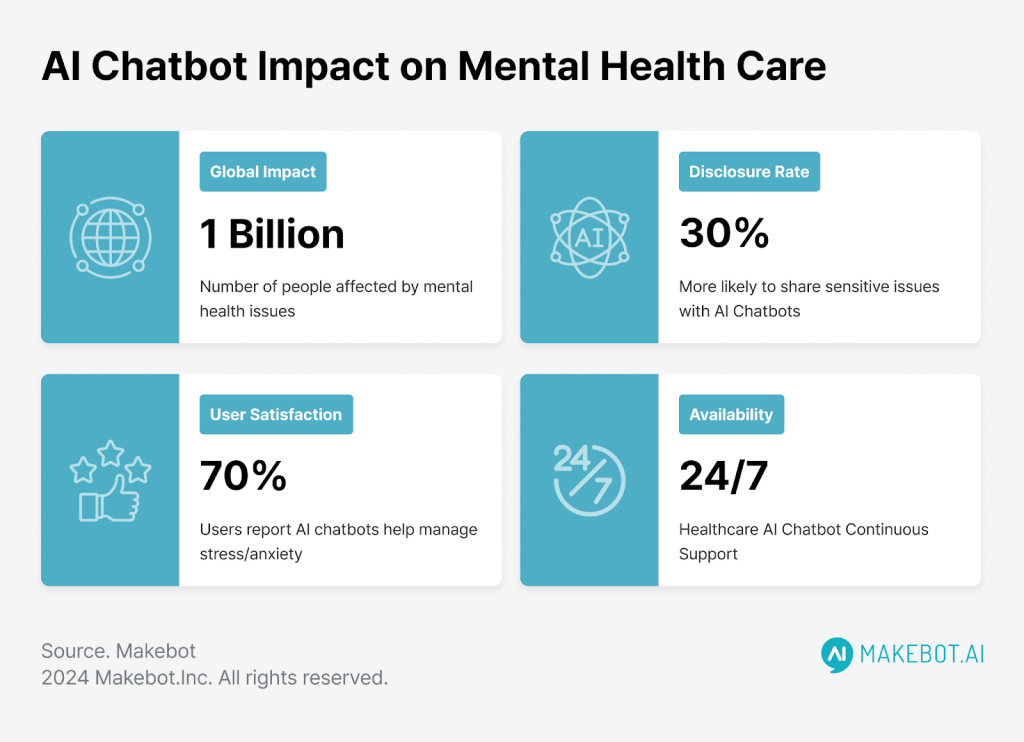
AI chatbot provides continuous 24/7 support availability, eliminating premium night and weekend staffing costs (Source: Makebot AI)
Traditional 24/7 support requires expensive night shift premiums, weekend staffing, and often offshore teams that introduce communication complexities. AI-driven CX eliminates these cost multipliers entirely.
Zendesk’s 2024 Customer Experience Trends Report reveals that SaaS companies operating AI chatbots reduce after-hours staffing costs by 70-80%. Instead of maintaining three full support teams across time zones, companies deploy AI chatbots for overnight and weekend coverage, with human agents handling only complex escalations during business hours.
Klarna’s implementation provides a compelling case study. Their AI assistant handles 2.3 million customer conversations monthly equivalent to 700 full-time agents operating continuously without breaks, vacations, or overtime costs. The financial impact: $40 million in annual cost avoidance while maintaining sub-2-minute response times globally.
3. Reduced Training and Onboarding Overhead
New support agent onboarding typically costs $15,000-$25,000 per hire, including training materials, mentor time, and reduced productivity during the 90-day ramp period. High turnover rates in customer support (18-25% annually) multiply these costs significantly.
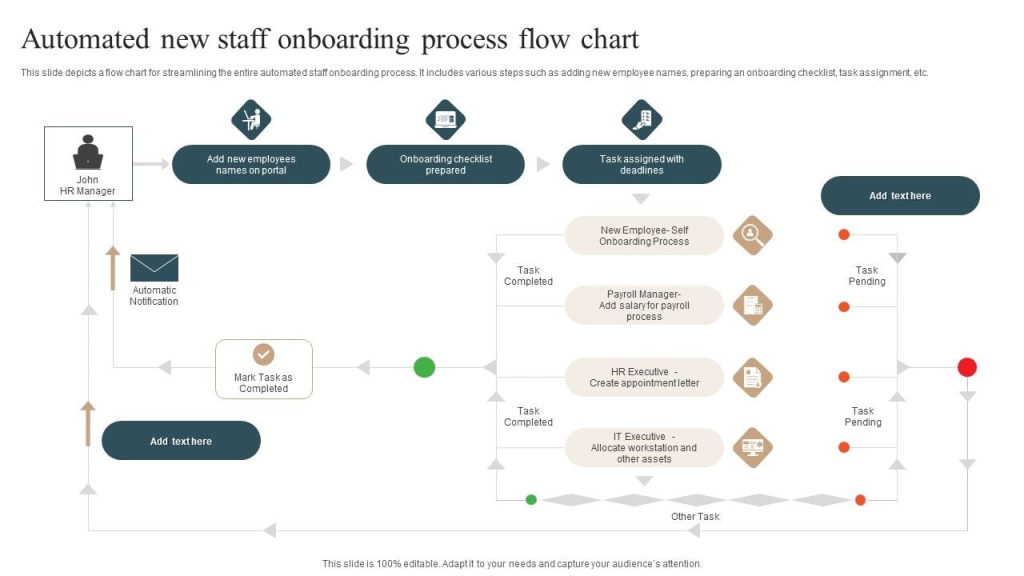
Automated staff onboarding flow chart reducing training time and manual overhead (Source: Tech HR visualization)
AI chatbots eliminate ongoing training expenses entirely. Once configured, they maintain consistent performance indefinitely, requiring only periodic updates when new features or policies are introduced. This represents a 90% reduction in knowledge transfer costs compared to human teams.
Microsoft’s analysis of their AI chatbot deployment showed that eliminating continuous training cycles freed up 15-20 hours per week of senior agent time, allowing those resources to focus on complex customer success initiatives rather than repetitive knowledge transfer.
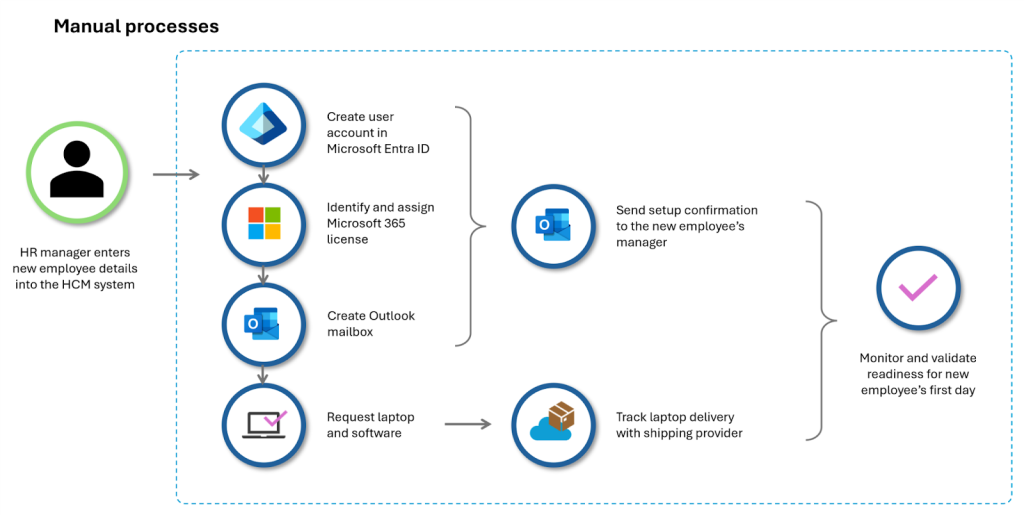
Manual onboarding inflates HR costs, while automation reduces both ramp-up time and labor overhead (source)
4. Instant Scalability During Peak Periods
SaaS companies experience predictable traffic spikes product launches, end-of-quarter renewals, system updates that traditionally require expensive temporary staffing or overtime authorization. These peak periods often increase support costs by 40-60% during critical business windows.

I assistants handle spikes in requests, answering 100% vs 65% by human teams (Source: Customer Experience Benchmark Report).
AI chatbots scale instantly to handle volume surges without additional cost. Whether processing 100 inquiries or 10,000, the marginal cost remains virtually zero. Generali’s insurance SaaS platform demonstrated this during their major system migration, where AI chatbots handled a 300% increase in support volume without requiring additional human resources or extended response times.
5. Elimination of System Integration Inefficiencies
The average SaaS support agent switches between 4-6 different systems per ticket resolution RM for customer data, ERP for subscription details, knowledge bases for solutions, and ticketing systems for case management. This context switching reduces productivity by 30-40% and increases resolution times significantly.
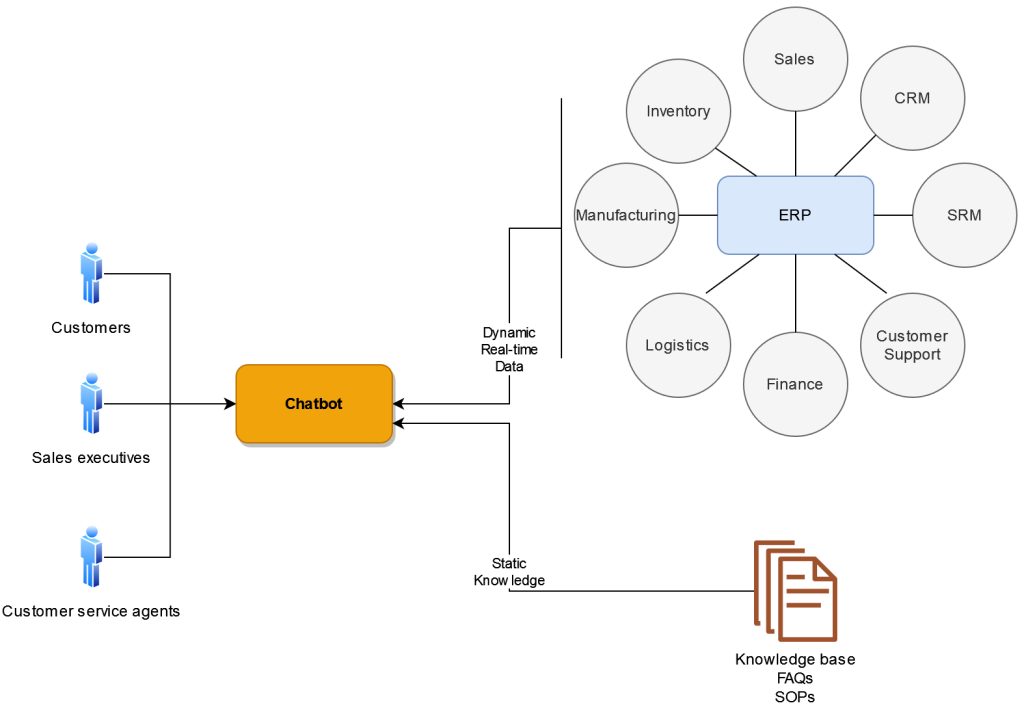
AI chatbot integrates CRM/ERP and knowledge base to eliminate context switching” (Source: internal system architecture example).
Modern AI chatbots integrate directly with CRM and ERP systems, accessing real-time customer data, subscription status, usage metrics, and transaction history simultaneously. This unified approach eliminates the inefficiencies that plague human agents operating across fragmented systems.
The productivity gain translates directly to cost reduction. Instead of requiring 8-10 minutes for account-related inquiries, AI chatbots complete the same resolutions in 2-3 minutes with higher accuracy rates.
6. Proactive Issue Prevention and Early Intervention
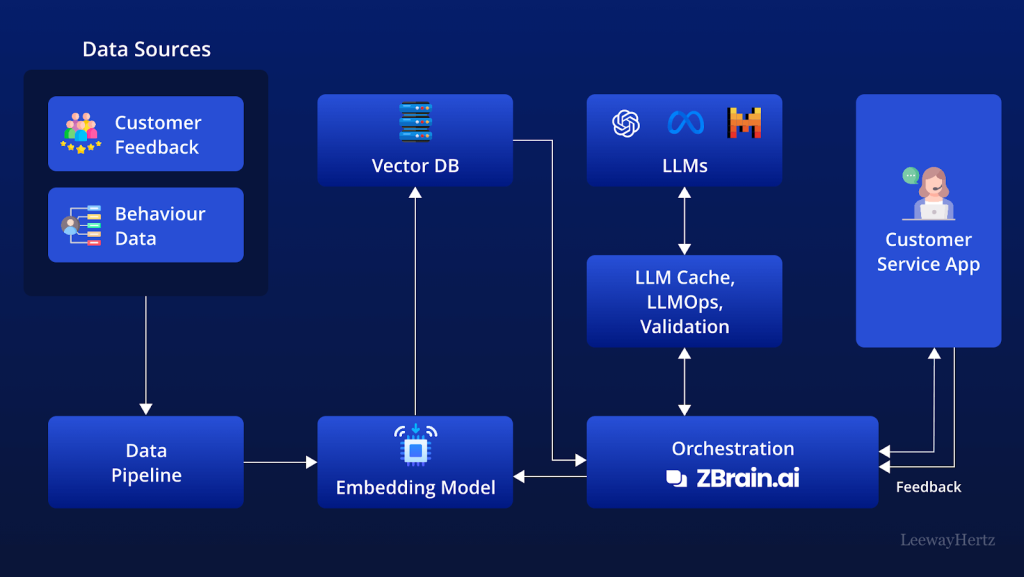
Data pipeline with customer feedback, behavior data, embeddings, and LLM integration for proactive issue detection (Source: LeewayHertz)
The most sophisticated cost reduction comes from preventing support tickets entirely. AI chatbots analyze customer behavior patterns, system usage data, and historical support trends to identify potential issues before they generate tickets.
Juniper Research’s 2024 study found that proactive AI interventions reduce overall ticket volume by 20-25% in mature SaaS implementations. By automatically reaching out to customers showing signs of confusion, billing concerns, or feature adoption challenges, AI chatbots resolve issues before they escalate to formal support requests.
This proactive approach represents the highest-leverage cost reduction strategy, as preventing a support ticket is infinitely more cost-effective than resolving one efficiently.
Summary
Individually, each lever reduces a significant cost component labor, overtime, training, or system inefficiency. Collectively, they restructure SaaS support economics. Industry data and case studies confirm that mature implementations consistently achieve 35–45% cost reductions, making ~40% savings both realistic and repeatable. This is why more SaaS executives now view AI chatbots in SaaS not as an experimental tool, but as a strategic lever to contain OPEX while strengthening customer experience.
Conclusion
Customer support costs represent a critical inflection point for scaling SaaS enterprises. Traditional labor-intensive models create unsustainable cost trajectories that threaten profitability as customer bases expand. AI chatbots in SaaS environments offer a proven pathway to restructure these economics fundamentally.
The 40% cost reduction isn’t theoretical, it’s being achieved through systematic automation of Tier 1 inquiries, elimination of premium staffing costs, reduced training overhead, instant scalability, system integration efficiencies, and proactive issue prevention. Leading SaaS companies are already operating with these new cost structures, creating competitive advantages that compound over time.
The implementation approach determines success. Basic FAQ bots deliver marginal improvements, while integrated intelligent automation platforms transform entire customer support operations. For SaaS executives committed to sustainable scaling, the question isn’t whether to deploy AI chatbots, but how quickly they can implement comprehensive automation that positions their companies for the next phase of growth while maintaining exceptional customer experience standards.
Twendee Labs specializes in building these intelligent, CRM/ERP-integrated chatbot systems helping SaaS enterprises cut support costs by up to 40% while elevating customer experience. Discover how Twendee can help you scale smarter, and stay connected via Telegram, X, and LinkedIn.
Read our latest blog here: Token Liquidity Engineering: From Zero to Sustainable Volume



